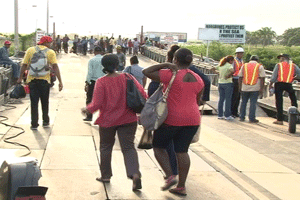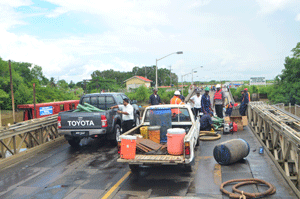GENERAL Manager of the Demerara Harbour Bridge Corporation, Rawlston Adams, yesterday, informed media personnel that 80% of the works to restore the section of the bridge that collapsed, when a temporary pontoon sank is completed and an interim measure has been put in place to assist commuters to get to Region 3.
 He added that it is expected that light vehicles will be able to use the bridge by this afternoon and a complete restoration of operations by Thursday or Friday. In the meantime, vehicles will be allowed to shuttle passengers up to the high span where they will walk across the bridge, and from the western end, board vehicles.
He added that it is expected that light vehicles will be able to use the bridge by this afternoon and a complete restoration of operations by Thursday or Friday. In the meantime, vehicles will be allowed to shuttle passengers up to the high span where they will walk across the bridge, and from the western end, board vehicles.
“We are hoping by the next tide to have that temporary pier on the western side installed; once that is installed, we will then move to install the original pontoon,” Adams said.
“What you are seeing here this morning is that we worked tirelessly last night to get to a stage of 80% of the works being completed…the bridge is now totally out of the water…we had to use three pontoons in terms of the salvage and recovery work…works are still ongoing,” Adams explained.
The works are tide sensitive and the maintenance teams have to wait on the next tide to continue working.
“We are working in shallow water…we have to wait for the water to go down so that we can have enough room for the temporary pier…this morning we contacted Mr. Eddie Vieira and he lent us a pontoon that is sufficient and can take the weight and support the western moored section…hopefully once that gets in, then we will start making adjustments on this pontoon so that we can lift it a little more, sink the pontoon then put it back in,” Adams explained.
weight and support the western moored section…hopefully once that gets in, then we will start making adjustments on this pontoon so that we can lift it a little more, sink the pontoon then put it back in,” Adams explained.
Cost Factor
Whilst cost is still being assessed, Adams emphasised that teams are working around the clock and management is not focusing on cost, but rather to ensure the bridge is again operational.
“It is a substantive cost, but except for that pontoon that is lent to us… all the resources deployed come from the bridge…this operation will attract additional costs to the organisation in terms of fuel, overtime and gas,” Adams explained. The nature of the routine maintenance which commenced over the weekend entailed replacing the ‘A’ frame which gives the connection between the bridge itself and the pontoon.
The nature of the routine maintenance which commenced over the weekend entailed replacing the ‘A’ frame which gives the connection between the bridge itself and the pontoon.
“Those A frames are very important in the structural integrity of the bridge…they were corroded and had to be changed…the works also entailed dredging which was done in excess of six months prior to the start on the weekend…we had to wait on the spring tide to facilitate the works…it gave us that extra lift,” Adams explained.
Damage to the bridge
Adams explained that there is no structural damage to the bridge, as “the temporary pontoon that we put in failed…there is no imminent danger to no other section of the bridge…the pontoons that the bridge sits on are single floatation units so there is no danger of anything like this happening at any other section of the bridge…the bridge structurally has a lifespan of 10 years,” Adams explained.
Adams however explained that the problem is not the structure of the bridge but rather the increasing number of vehicles traversing it, which may make the bridge inefficient, thereby not being able to serve its intended purpose of moving goods and services in an efficient manner.
“Traffic is growing… over the past few years at 8% …in another four to five years the bridge will be so much congested-it will be totally choked…on that basis a new bridge is justified,” Adams said.
The Harbour Bridge general manager said that the nature of the works that had to be executed recently can only be done in the spring tide, as it allows for maximum draft so that operations can be done in that specific area, assisted by the necessary dredging.



.jpg)








